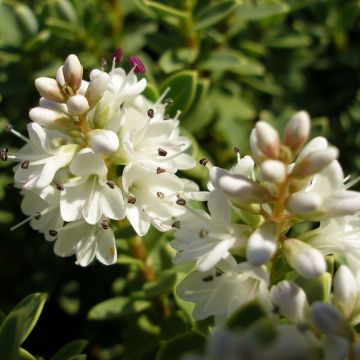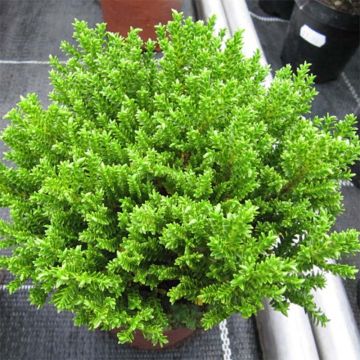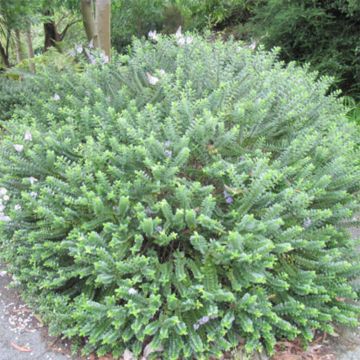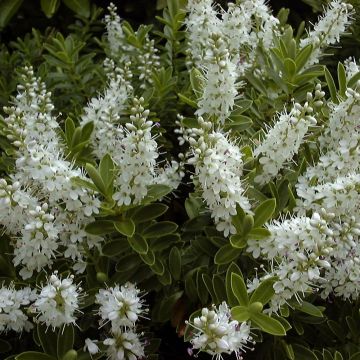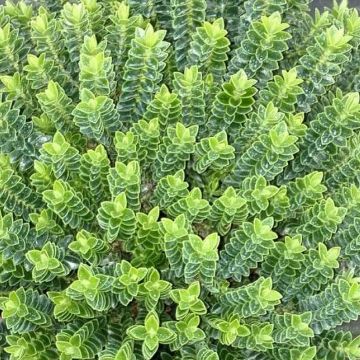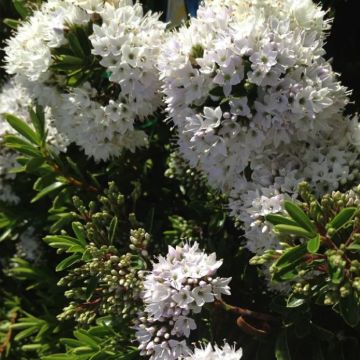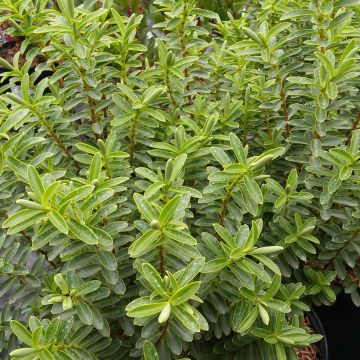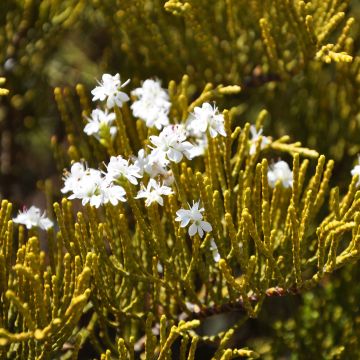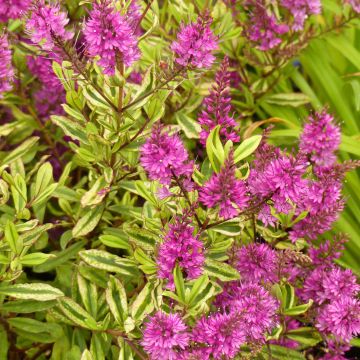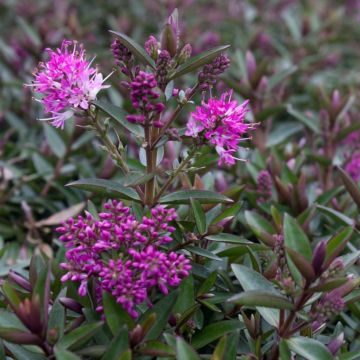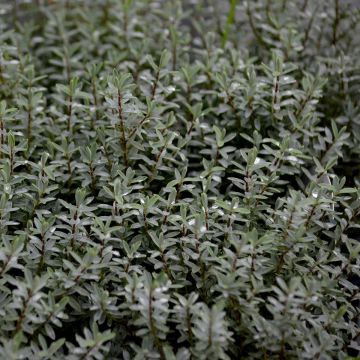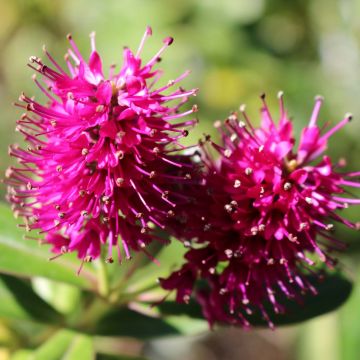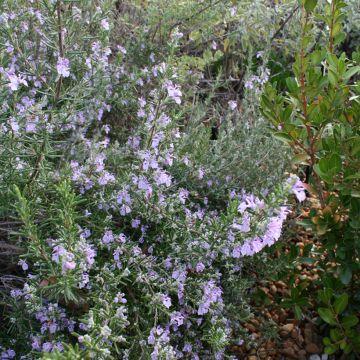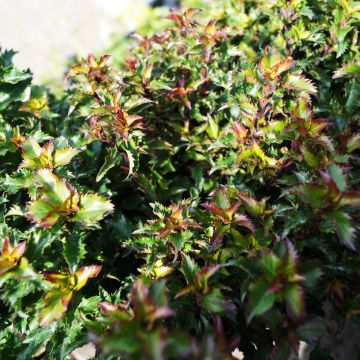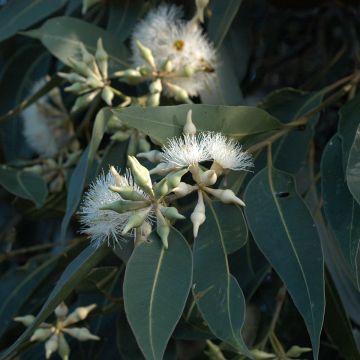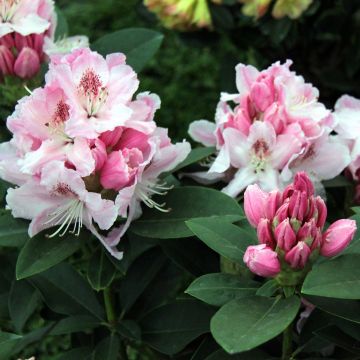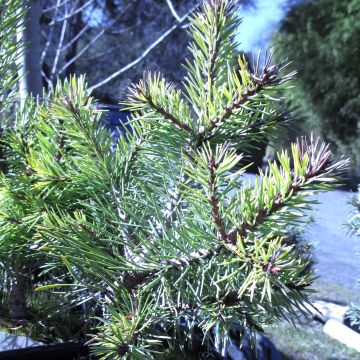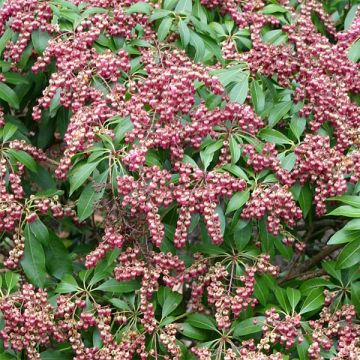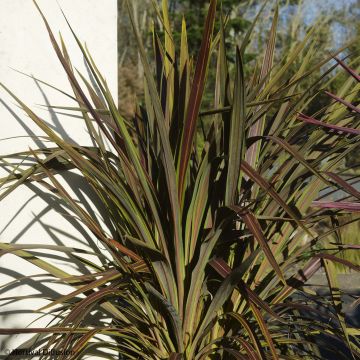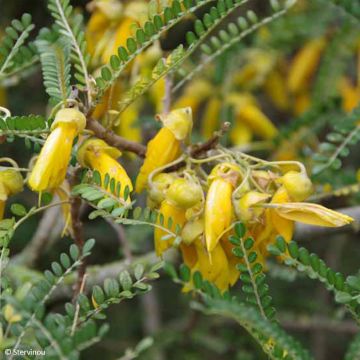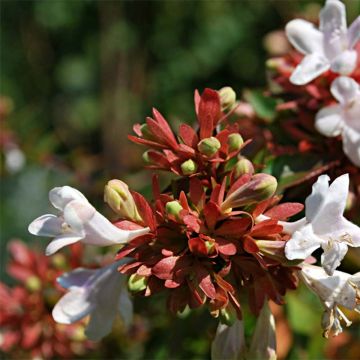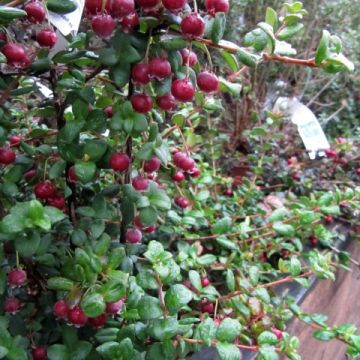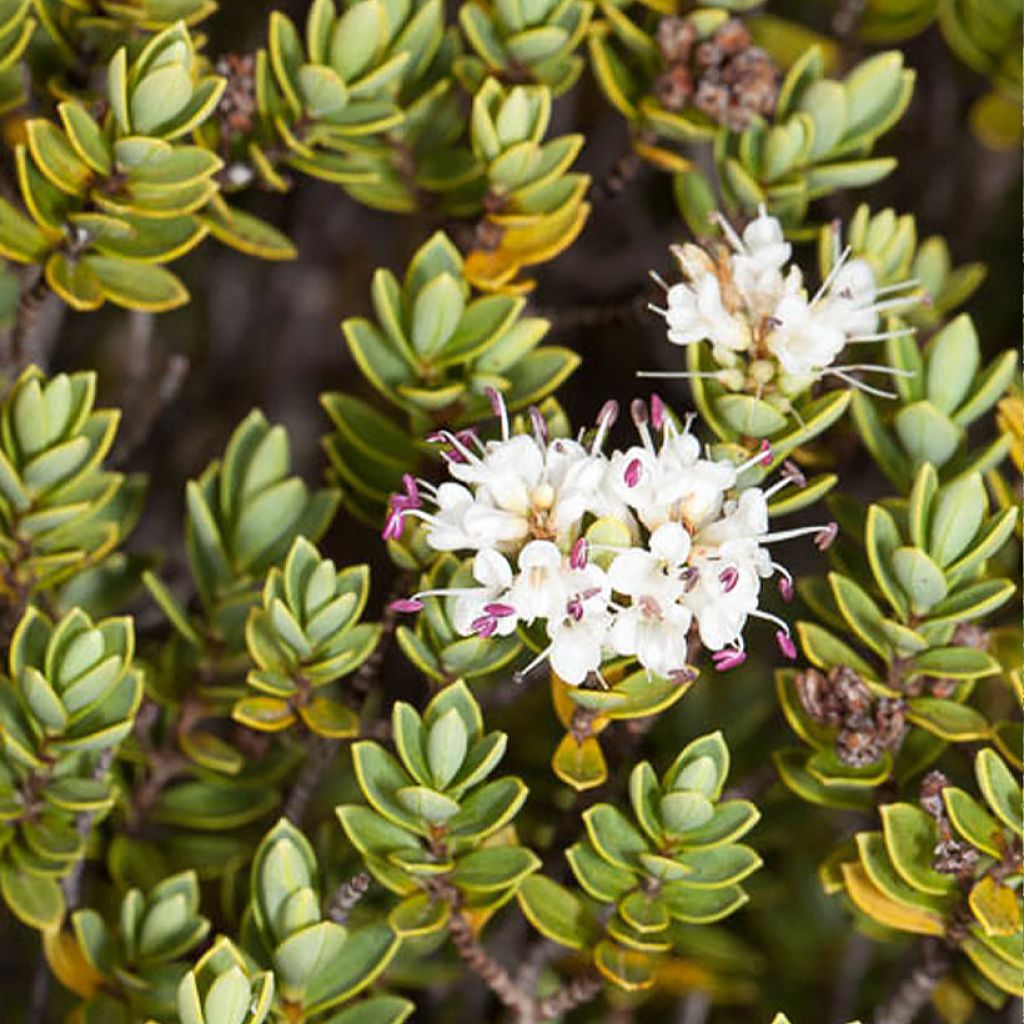

Hebe topiaria - Topiarist's hebe
Hebe topiaria - Topiarist's hebe
Hebe topiaria
Box-leaved Hebe, Hebe Topiary, Shrubby Veronica
Why not try an alternative variety in stock?
View all →This plant carries a 24 months recovery warranty
More information
We guarantee the quality of our plants for a full growing cycle, and will replace at our expense any plant that fails to recover under normal climatic and planting conditions.
From €5.90 for pickup delivery and €6.90 for home delivery
Express home delivery from €8.90.
Does this plant fit my garden?
Set up your Plantfit profile →
Description
Hebe topiaria is a variety of bushy veronica attractive for its highly sculptural habit. It forms a small bush that naturally creates a dome of foliage, broader than it is tall. Its very fine and evergreen, grey-green folage, is ornamental in every season. At the end of spring, short spikes of small white flowers appear, well-matched to the vegetation. Easy to cultivate in most well-drained soils, this species is notably more resistant to cold than others and also tolerates coastal climates.
Bush veronicas were once part of the Veronica genus but are now grouped within the Hebe genus. This genus, long classified within the Scrophulariaceae, is now included in the Plantaginaceae family, alongside wild herbs like Plantain and also ornamental plants such as the magnificent Siberian Veronica (Veronicastrum sibiricum), with its oversized floral spikes.
There are around a hundred species of Hebe, the vast majority of which are native to New Zealand, with others coming from southern Australia or Tasmania. The first bush veronica (Hebe elliptica) was introduced to Europe in 1775 following an expedition by the famous Captain Cook.
Originating from New Zealand, Hebe topiaria has been awarded a prestigious Award of Garden Merit by the Royal Horticultural Society (RHS) for its ornamental qualities. It is a botanical species of good hardiness (-12°C to -15°C) and has a relatively significant growth rate compared to others, as in 5 years of cultivation, it will reach approximately 1 m in height and 1.20 m in spread. At maturity, after 10 years, if the soil and climatic conditions are suitable, it could even grow to 1.20 m with a width of 1.50 m. The bush naturally adopts a very regular hemispherical habit, even without pruning. This highly geometric silhouette is particularly valued in contemporary gardens, where structure takes precedence over flowers. The fine stems of a chartreuse green are adorned with a multitude of small elliptical leaves, with pointed tips, measuring around one centimetre in length. Their colour is stunning, ranging between moss green and grey-green, enhancing the stylish appearance of the plant and exuding a sense of serenity. The leaves are opposite, decussate, meaning that each node rotates 90° relative to the previous one. When viewed from the front, the branches display leaves that form a cross. Aligned one behind the other, they appear almost overlapping due to the short internodes.
From June until July, the plant produces a charming flowering, albeit sometimes sparse. Spikes of 3 cm in length then form, made up of small pure white flowers. Their colour harmonises beautifully with that of the leaves, giving this Veronica a pleasant and tasteful romantic touch.
Hebe topiaria is a true botanical sculpture with an almost perfect design, ideal for dressing a border at the foot of a hedge, adding character to a large rockery or bringing a touch of distinction to a flowerbed. Its distinctive silhouette provides form contrasts when paired with columnar plants, such as Juniperus scopulorum 'Blue Arrow', a fastigiate Virginia Juniper, whose bluish foliage will perfectly complement that of your Hebe. A specimen of Viburnum tinus 'Spirit' will allow you to enjoy pale pink flowering throughout the winter. You can prune this Laurustinus into a cone or any shape you prefer to accentuate the geometric aspect of your scene. A topiary of Ilex crenata 'Convexa', a small holly with fine evergreen non-thorny foliage, will fit into the same spirit. And to animate these almost too perfect forms, add a different element with a specimen of Loropetalum chinense 'Pipa's Red', a superb bush with an irregular habit that you should not prune. Let it add a different form with its tousled appearance and its purple-bronze foliage that will create a subtle contrast of colours among the other plants.
Report an error about the product description
Plant habit
Flowering
Foliage
Botanical data
Hebe
topiaria
Plantaginaceae
Box-leaved Hebe, Hebe Topiary, Shrubby Veronica
Veronica topiaria
Oceania
Other Hebe - Shrubby Veronica
Planting and care
Easy to care for, Hebe topiaria prefers sunny situations and well-drained soils that do not retain too much water. It tolerates salt spray quite well and adapts very well to coastal gardens. Water it regularly during the first year to help it establish a strong root system, then in summer. Once established, it can withstand short periods of drought. Relatively hardy, it can resist temperatures down to -12°C / -15°C. In the coldest regions, it is advisable to protect it during winter with a breathable covering during periods of severe frost. After flowering, remove the faded inflorescences using pruning shears. This light trimming will help maintain a compact habit.
Planting period
Intended location
Care
This item has not been reviewed yet - be the first to leave a review about it.
Evergreen shrubs
Haven't found what you were looking for?
Hardiness is the lowest winter temperature a plant can endure without suffering serious damage or even dying. However, hardiness is affected by location (a sheltered area, such as a patio), protection (winter cover) and soil type (hardiness is improved by well-drained soil).

Photo Sharing Terms & Conditions
In order to encourage gardeners to interact and share their experiences, Promesse de fleurs offers various media enabling content to be uploaded onto its Site - in particular via the ‘Photo sharing’ module.
The User agrees to refrain from:
- Posting any content that is illegal, prejudicial, insulting, racist, inciteful to hatred, revisionist, contrary to public decency, that infringes on privacy or on the privacy rights of third parties, in particular the publicity rights of persons and goods, intellectual property rights, or the right to privacy.
- Submitting content on behalf of a third party;
- Impersonate the identity of a third party and/or publish any personal information about a third party;
In general, the User undertakes to refrain from any unethical behaviour.
All Content (in particular text, comments, files, images, photos, videos, creative works, etc.), which may be subject to property or intellectual property rights, image or other private rights, shall remain the property of the User, subject to the limited rights granted by the terms of the licence granted by Promesse de fleurs as stated below. Users are at liberty to publish or not to publish such Content on the Site, notably via the ‘Photo Sharing’ facility, and accept that this Content shall be made public and freely accessible, notably on the Internet.
Users further acknowledge, undertake to have ,and guarantee that they hold all necessary rights and permissions to publish such material on the Site, in particular with regard to the legislation in force pertaining to any privacy, property, intellectual property, image, or contractual rights, or rights of any other nature. By publishing such Content on the Site, Users acknowledge accepting full liability as publishers of the Content within the meaning of the law, and grant Promesse de fleurs, free of charge, an inclusive, worldwide licence for the said Content for the entire duration of its publication, including all reproduction, representation, up/downloading, displaying, performing, transmission, and storage rights.
Users also grant permission for their name to be linked to the Content and accept that this link may not always be made available.
By engaging in posting material, Users consent to their Content becoming automatically accessible on the Internet, in particular on other sites and/or blogs and/or web pages of the Promesse de fleurs site, including in particular social pages and the Promesse de fleurs catalogue.
Users may secure the removal of entrusted content free of charge by issuing a simple request via our contact form.
The flowering period indicated on our website applies to countries and regions located in USDA zone 8 (France, the United Kingdom, Ireland, the Netherlands, etc.)
It will vary according to where you live:
- In zones 9 to 10 (Italy, Spain, Greece, etc.), flowering will occur about 2 to 4 weeks earlier.
- In zones 6 to 7 (Germany, Poland, Slovenia, and lower mountainous regions), flowering will be delayed by 2 to 3 weeks.
- In zone 5 (Central Europe, Scandinavia), blooming will be delayed by 3 to 5 weeks.
In temperate climates, pruning of spring-flowering shrubs (forsythia, spireas, etc.) should be done just after flowering.
Pruning of summer-flowering shrubs (Indian Lilac, Perovskia, etc.) can be done in winter or spring.
In cold regions as well as with frost-sensitive plants, avoid pruning too early when severe frosts may still occur.
The planting period indicated on our website applies to countries and regions located in USDA zone 8 (France, United Kingdom, Ireland, Netherlands).
It will vary according to where you live:
- In Mediterranean zones (Marseille, Madrid, Milan, etc.), autumn and winter are the best planting periods.
- In continental zones (Strasbourg, Munich, Vienna, etc.), delay planting by 2 to 3 weeks in spring and bring it forward by 2 to 4 weeks in autumn.
- In mountainous regions (the Alps, Pyrenees, Carpathians, etc.), it is best to plant in late spring (May-June) or late summer (August-September).
The harvesting period indicated on our website applies to countries and regions in USDA zone 8 (France, England, Ireland, the Netherlands).
In colder areas (Scandinavia, Poland, Austria...) fruit and vegetable harvests are likely to be delayed by 3-4 weeks.
In warmer areas (Italy, Spain, Greece, etc.), harvesting will probably take place earlier, depending on weather conditions.
The sowing periods indicated on our website apply to countries and regions within USDA Zone 8 (France, UK, Ireland, Netherlands).
In colder areas (Scandinavia, Poland, Austria...), delay any outdoor sowing by 3-4 weeks, or sow under glass.
In warmer climes (Italy, Spain, Greece, etc.), bring outdoor sowing forward by a few weeks.

































